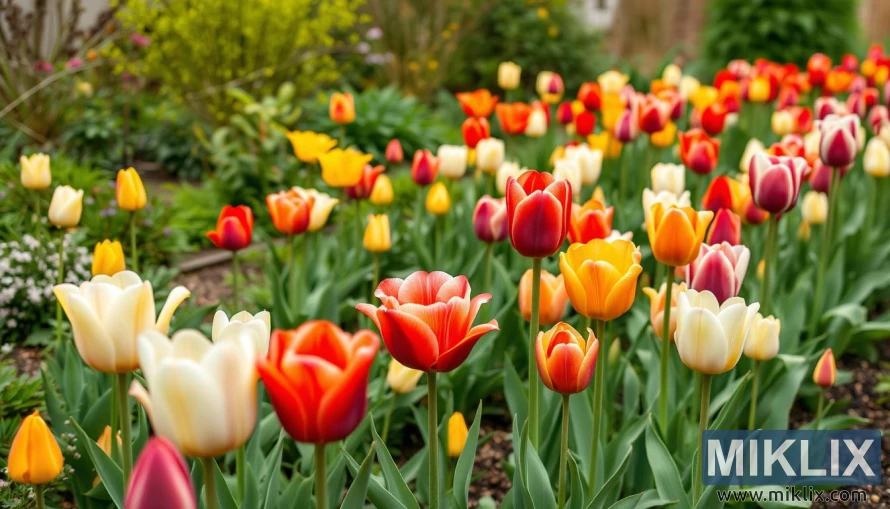Image: Lively Spring Tulip Garden
Published: August 22, 2025 at 9:00:28 AM UTC
Last updated: September 27, 2025 at 11:02:10 PM UTC
A cheerful tulip garden features multicolored blooms on green stems, set against lush foliage in a vibrant springtime scene.
The tulip garden in this image bursts forth with an effervescent energy, its mosaic of colors creating a scene that feels both lively and serene. Each tulip rises proudly on a slender green stem, the smooth leaves surrounding them providing a lush and balanced frame for the blooms. The petals, polished and velvety, curl slightly outward in an elegant display, forming graceful cups that cradle the light. Together, they seem to converse with one another, their different hues harmonizing into a chorus of spring’s renewal. It is a garden alive with contrast and charm, where no single blossom dominates, yet each contributes to a collective vibrancy.
The variety of shades is striking. Deep reds glow with intensity, their bold tones evoking warmth and passion, while sunny yellows and golden oranges radiate cheerfulness and energy. Soft whites, delicate and pure, provide a gentle counterpoint to the richer colors, creating moments of calm within the garden’s lively rhythm. Interspersed among them are tulips tinged with blush pink or accented with subtle gradients that transition from one shade to another, adding depth and intricacy to the display. The interplay of colors captures the essence of diversity within nature, where harmony is born not from uniformity, but from variation and balance.
Unlike the rigid rows of formal gardens, this arrangement has a more natural and scattered appearance, giving it a sense of spontaneity and freedom. The tulips lean at slight angles, some reaching higher toward the light while others bow gracefully, as if responding to an invisible breeze. This fluidity makes the scene feel alive, as though the garden itself were breathing, its rhythm measured by the cycle of opening petals and swaying stems. The earth below, dark and fertile, anchors this exuberance, a reminder of the life-giving soil from which all beauty springs.
In the background, dense foliage and shrubs provide a rich green backdrop that enhances the brilliance of the tulips in the foreground. The contrast is striking: the tulips’ saturated colors glow all the more brightly against the darker, cooler tones of the leaves and plants behind them. The layering of garden textures—broad leaves, fine stems, tiny blossoms peeking here and there—adds visual depth, making the tulip bed seem expansive and immersive. It is a tapestry woven with countless shades and shapes, each thread playing its role in the whole.
Sunlight bathes the scene with a warm glow, accentuating the tulips’ natural sheen and bringing out the subtle variations in their petals. The light transforms the garden into a space of enchantment, where every color appears more vibrant and every detail more refined. Shadows play softly among the stems, adding depth and dimension to the composition. It is a moment in time where nature’s beauty feels heightened, caught at the peak of its seasonal expression.
Altogether, the scene exudes cheerfulness and tranquility in equal measure. There is energy in the bright blooms, yet peace in the soft arrangement and the way the tulips coexist in effortless harmony. It is a place that invites one to linger, to stroll slowly among the flowers, or simply to pause and breathe in the atmosphere of renewal. In the garden’s lively colors and graceful forms, one finds not only the joy of spring but also a quiet reminder of life’s resilience and beauty, ever unfolding with the changing seasons.
The image is related to: A Guide to the Most Beautiful Tulip Varieties for Your Garden

